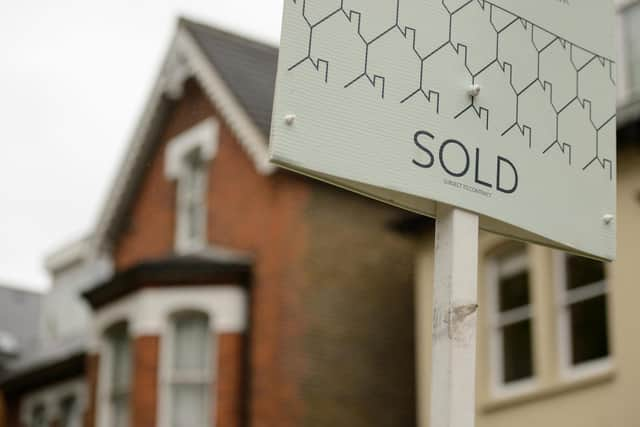House prices in Sheffield and Leeds boom sparked by a flight back to cities
In contrast, North Yorkshire, a hotspot for those fleeing cities during the height of the pandemic, has seen much lower price rise of 5.5 per cent.
Halifax say that since the start of the year, as people increasingly returned to the office and were once again able to make the most of leisure opportunities, property prices in cities have grown by an average 9.2 per cent, while in surrounding areas it was much less, at 7.9 per cent.
Advertisement
Hide AdAdvertisement
Hide AdWhile the picture still varies significantly in and around individual cities across the country, this suggests a shifting in homebuyers’ post-pandemic priorities.


Andrew Asaam, Mortgages Director, Halifax, said: “The pandemic transformed the UK housing market. Homeowners wanted bigger homes and better access to green spaces, fueling huge demand for larger properties away from urban centres. This accelerated house price growth in the suburbs and more rural areas, while in cities it was much slower.
“That trend didn’t disappear completely this year, as house price growth in these areas remained strong. But, as daily life started to get back to normal for many, the opportunity to live in cities became more attractive again, driving up demand. There’s evidence of this in locations across the country, with property price inflation in the majority of cities outstripping increases in their surrounding areas.
“Clearly the economic environment has changed considerably in the last few months, with the likelihood of more significant downward pressure on house prices, as the cost of living squeeze and higher borrowing costs limit demand. The extent to which such trends will continue to shape the housing market is therefore uncertain.”
Advertisement
Hide AdAdvertisement
Hide AdElsewhere, in the North West, the cities of Liverpool (+8.9%) and Manchester (+11.5%) have seen much stronger house price growth so far this year, compared to their surrounding areas (+7.2% and +6.6% respectively); in Bury, for example, prices have risen by just +1.3%.
It’s a similar story in Scotland, where both Edinburgh (+12.9%) and Glasgow (+8.5%) have seen property price inflation increase much more quickly since the turn of the year, compared to their surrounding areas (+6.1% and +4.6% respectively). This has been reflected in places like Fife (+2.1%) and West Dunbartonshire (-0.7%).
And in Greater London it’s a tale of two cities, with inner London boroughs recording average property price growth of +6.8%, compared to +4.6% in the outer boroughs. Brent is one of only a handful of London boroughs to see prices fall so far this year, down -8.4%.
This picture is in contrast to the North East however, where the cities of Newcastle (+6.4%), and Sunderland (+5.3%) and Middleborough (-2.2%) are seeing lower growth than their surrounding areas. South Tyneside leads the way for house price growth in the region, up by +14.0% over the last nine months.
Advertisement
Hide AdAdvertisement
Hide AdLikewise in Birmingham, where growth in the surrounding areas (+9.4%) has been stronger than the city itself (+8.6%) this year. This is reflected in places like Walsall, which has seen property price inflation of +16.4% over the same period.
Meanwhile, the latest Rightmove reports shows that average asking rents for new tenants outside of London have risen to a new record of £1,162 per calendar month. This quarter’s increase of 3.2% is only the third time on record that rents have increased by 3% or more in a quarter, as new asking rents continue to rise rapidly.
In London, average asking rents rise to a record of £2,343 pcm this quarter. This puts the annual rate of asking rent growth in the capital at 16.1%, the highest yearly rate of growth of any region on record.
The pace of asking rent growth is primarily down to the severe shortage of available rental properties, combined with extremely high demand which continues to surpass even last year’s levels in every region and country of Great Britain.
Advertisement
Hide AdAdvertisement
Hide AdDemand is up by 20% compared with last year, while the total number of available properties to rent is down by 9%. This widening gap between supply and demand is creating ever fiercer competition between tenants looking for a home.
Rightmove’s Director of Property Science Tim Bannister said: “It’s a real challenge for renters at the moment, as there are simply not enough homes available to rent to meet the demand from people enquiring.
"Whilst it's positive news that most areas are seeing more properties coming to market, with London the notable exception, ultimately the gap between supply and demand is becoming wider across the board. We will need a significant addition of homes to come onto the market to even begin to balance the scales. Those looking to rent a smaller property in the next few months may find that they face some added competition from would-be first-time buyers, who have had their purchase plans scuppered for now due to the sudden rise in mortgage interest rates, and are now looking to rent.”